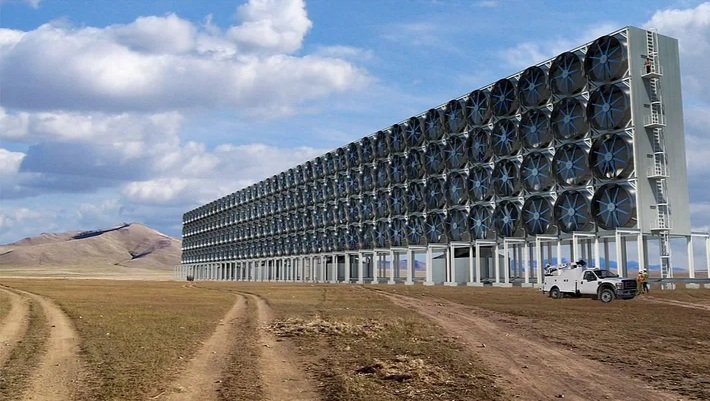Sending Gifts Made Out of Thin Air
Photo: Carbon Engineering plant via Science.org
In Israel, it’s customary to send gifts to friends and colleagues to celebrate Rosh Hashana, the Jewish New Year. So what to gift our LPs, a group of ardent impact enthusiasts, environmental activists, and globetrotting (we offset, we promise!) shirkers of “stuff” who have joined us in our journey to make this world a bit better in the year 5783 and beyond?
Air. We sent them air.
More specifically, we paid Climeworks — a direct air capture (DAC) startup operating in Switzerland and Iceland aiming to capture 1% of global emissions by 2025 with the help of customers such as Square, Stripe, Microsoft and UBS, and with a recent injection of $650M in their Series F round — to process enough air to extract and sequester 1,425 kg (a.k.a. 1.425 metric tons) of CO2. At 415.7 ppm, or a mere 0.04% of air’s total composition, that’s a lot of air to process.
Pretty cool, huh?
Meh. Not so much…
For starters, 1.425 tons is a totally inconsequential amount of CO2. As per MIT’s Climate Portal, it would offset one passenger car driving from Portland, Maine to Tijuana, Mexico. Furthermore, WRI reports that the current capacity of the largest DAC companies’ 18 plants is only 8,000 tons annually. This is a far cry from the 51 billion tons of CO2e we emit annually and the estimated five to 10 billion tons we will need to proactively extract from the atmosphere each year to meet 1.5C targets.
Secondly, direct air capture is WAY expensive. For reference, we paid Climeworks $1,200 per ton of carbon sequestered, while we could have purchased per ton carbon credits from mitigation projects — think reforestation or wind farms — for as little as $20 per ton.
Photo: Climeworks facility in Switzerland
So why would we and 16,530 other people and companies across 53 countries be crazy enough to shell out cash to be a Climeworks’ customer?
Not all carbon credits are created equally. DAC companies like Climeworks provide the gold standard of carbon credit because they are actively erasing the impact of one ton of CO2e already emitted into the atmosphere (the “draining the tub” metaphor), while the majority of available carbon credits come from offset programs designed to pay companies to avoid making additional emissions in the future (slowing the flow of water into the bathtub). And even those carbon credits that do extract CO2 from the atmosphere (e.g. reforestation) often offer only limited or questionable durability (how long that CO2 stays locked up). We need solutions that we know will sequester CO2 for 1,000+ years, not for a few handfuls of decades.
It is transparent and measurable. Climeworks and competitors in the DAC space are setting the standards for accountability that will enable a functional and large-scale carbon market to develop. Together with standard bearers like puro.earth and third-party verifiers, they are proactively committing to account for every ton of CO2 in a way that is verifiable and as permanent as possible, not the “creative accounting” of many low-cost carbon credit projects.
We are at the beginning of a steep cost curve in DAC and in direct carbon removal projects (DCR) more broadly. Companies have begun construction of DAC plants with capacity of up to 1M tons annually and we can expect costs to descend dramatically as we approach this scale. More crucially, we anticipate a host of alternate and lower-cost DCR technologies (e.g. ocean-based) to come on-line, making DAC one of many tools in the toolbox.
Our support of Climeworks at this stage is of course symbolic. (Microsoft and friends of course have the scale and resources to make these purchases a bit more meaningful, no doubt at far lower prices than our retail 25kg for $30 a pop.) Nevertheless, this support as an important part of our learning journey at ZORA as we continue to explore the most scalable and cost-effective DCR solutions. As we stand at the beginning of this cost curve, we see tremendous potential for the entrepreneurs and technologies who will bend that arc toward scale and will mainstream carbon capture over the next decade.



